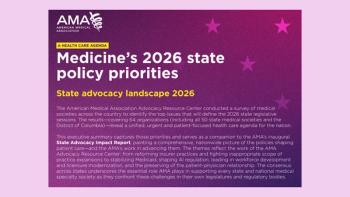
Chronic Care Codes Offer Greater Flexibility and Payment in 2020
Here are the new CMS coding changes and ways to maximize reimbursement and care management efficiency.
When the Centers for Medicare and Medicaid Services (CMS) introduced chronic care management (CCM) services and the associated codes in 2015, the reaction was, to put it mildly, underwhelming. Although physicians were pleased that they were, at last, being paid for the overlooked extra care delivered to their patients with chronic conditions, only
One of the main reasons for the low participation levels was the lack of flexibility of the new codes. To bill for CCM, for example, two or more chronic conditions were required, providers were only permitted to bill either for a 20- or 60-minute increment and physician specialists were largely unable to participate. Physicians also felt that the first CCM codes did not adequately compensate them for the time or attention dedicated to these often highly complex, high-risk patients.
Since then, CMS has relaxed many of those rules and improved reimbursement- and 2020 is no exception. Along with changes to CCM, the agency announced updates for its Transitional Care Management (TCM), Remote Physiologic Monitoring (RPM) and new Principal Care Management (PCM) codes that should encourage more providers to participate. Not only does this present the opportunity to earn more revenue, but offering the services described in the codes can improve condition management, engagement and outcomes for their patients.
The following are the substantial coding changes along with some insight into how to maximize reimbursement and care management efficiency.
CCM: Less Restrictive Time Limits
For 2020, CMS added new codes for CCM to accommodate differing amounts of time spent on care management. Now, providers can bill for 20 and 60 minutes of management (99490 and 99487), but also 30 minutes (99491). There is also a separate code for each additional 30 minutes of management (99489).
Noting that many patients require additional time for non-complex care planning, CMS announced a new add-on G-code (G2058) for each additional 20 minutes of clinical staff time directed by a physician or other qualified health care professional, which can be billed in conjunction with 99490 up to twice per month.
To stay efficient in delivering these CCM services, practices and health systems should use a tiered approach, starting with identifying and prioritizing their top 3% highest-cost, highest-risk patients. Those patients should likely be managed internally since care teams already devote significant care resources to them. Partnering with a third-party care management service for the remaining top 10% to 20% highest risk patients may be more cost-effective than trying to manage all internally, depending on patient volume.
To maximize the benefit for all parties, providers should dedicate the time spent during CCM services to manage care gaps, schedule overdue annual wellness visits, and complete hierarchical condition category (HCC) coding opportunities, among other activities.
TCM: Unbundled to Encourage Adoption
Although
To maximize reimbursement, however, patients must receive a face-to-face visit from their primary care physician within 7 to 14 days post-discharge. That is why primary care physicians need connectivity to a health information exchange and/or hospital admission-discharge-transfer (ADT) feed for the timely identification of eligible patients as well as automated provider notification. Population health management (PHM) data analytics technology can also help providers understand the root cause of admissions and develop care management plans to prevent readmissions.
PCM: Specialists Get Involved
CCM and other such codes have been predominately focused on services delivered by primary care physicians, which unfortunately limited the involvement of specialists who play a valuable management role. For the 2020 coding update, CMS appears to be trying to involve more members of the extended care team by introducing Principal Care Management for patients with a single-complex condition lasting three or more months. The new G-codes (G2064 and G2065) make it possible for primary care and specialists to collaborate by providing high-risk disease-specific care management and together obtain reimbursement for the complex care planning and frequent medication changes that are often required for such patients.
RPM: Opening the Door to Partners
The Remote Physiologic Monitoring (RPM) codes were a major step forward in encouraging providers to use advanced technology, such as wireless connected wearables, to track biometrics and identify a patient’s potential decompensation and prevent an adverse event. The monitoring, however, needed to occur “under the direct supervision of the billing provider” according to the previous rule. The 2020 coding update allows clinical staff to operate under the “general supervision” of the billing provider. This means providers can partner with remote patient monitoring management vendors who can help alleviate the burden of monitoring lower-risk patients, for example, and allow providers to dedicate more resources toward the highest-need patients without losing out on the new codes’ reimbursement
Mastering the Codes
As with all CCM and related coding sets, providers will need to ensure they have a dynamic scheduling and care planning tool that helps them keep track of the time spent with eligible patients. Such a PHM platform should also support accurate and complete coding with thorough and timely data and documentation that can help physicians capture more deserved payment for the myriad of care services they deliver to their highest-need patients.
About the author:
Alexis Edwards is Director of Client Services at Lightbeam Health.
Newsletter
Stay informed and empowered with Medical Economics enewsletter, delivering expert insights, financial strategies, practice management tips and technology trends — tailored for today’s physicians.








